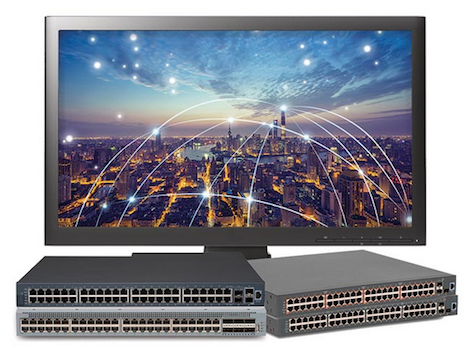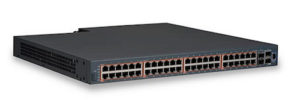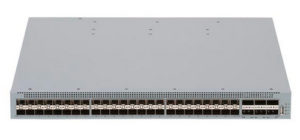
The advent of IP-cameras and continuing transition to computer-based networking surveillance systems has placed much attention on IP-cameras and computer servers (network video recorders [NVRs/DVRs]). These computer servers and NVR solutions have been focused around performance capabilities, bitrate throughput management, and the number of IP-cameras that can be attached to each server/NVR.
Some technical professionals may take offense to the following statement, but our technical tendency whenever a server/NVR starts to drop frames or ?go black? is to start dropping camera resolutions, drop frame rates, or drop camera bitrates, and/or add more servers/NVRs.
So little attention, historically, has been paid to the actual ?network? equipment in these network video recording solutions.
Not so un-noticed, video surveillance puts such a tremendous load on I.P. networks (just ask the corporate network admin) and has been a major bottleneck component since the first network surveillance camera came online. Where typical corporate networks have been more plug-and-play in their usage, video surveillance pushes the geek level of network management to a much higher level of sophistication.
If we are honest with ourselves, this intimidates many physical security/video surveillance professionals.
To be fair, these security professionals are not computer networking experts. Trying to understand the impact RTSP has on a network or the importance of every frame making it from end-to-end has not been as important to some smaller installations. However, when keeping a video feed pumping with no interruption is important then it becomes vital to understand the network configurations.
Whether it is a small number of (critical) cameras or an installation at a prison, airport, theme park, or even a mass transit system with 1,000 or more cameras being able to leverage multicast networking at the edge and still create scalability. Previously, a network manager would look at how to implement multicast versus unicast or Protocol Independent Multicast (PIM) and then PIM Sparse Mode versus PIM Dense Mode technologies. Now we are crossing over into some heavy geekness.
Having an understanding of multicast, unicast, routing tables, RTSP, IGMP proxies, OSPF, PIM, and more means you probably are a CCNA.
BCDVideo, a video surveillance storage and networking manufacturer, has realized the immense importance of the actual network components of a video surveillance infrastructure and is putting significant focus on network equipment offerings. This new focus is putting a spotlight on network switches and the ability of those products to handle surveillance video feeds. Without ?going black.?
?We found that most of the ?problems? with surveillance systems were actually improper network configuration,? stated Tom Larson, Director of Sales & Engineering at BCDVideo. ?In order to properly setup the network, you typically needed a certified network technician or be certified yourself. BCDVideo looked to networking to see who could provide a better solution for the video surveillance market and we found Avaya.?
BCDVideo has teamed with Avaya to deliver the Titan family of networking solutions based on the Avaya Fabric Connect with Shortest Path Bridging capabilities. This is game changing. And if you think this is just some article about a vendor picking up a new product, you need to keep reading.
Avaya works to simplify multicast networking. With just a few lines of code added to a Titan switch?s software, these devices are set-up and ready for operation. They also are equipped with Avaya?s Fabric Connect and offer Shortest Path Bridging, enabling an Active-Active topology, keeping both links active to transport data and efficiently load-balance the video data. Having Avaya design these switches with video surveillance becomes an ideal solution for those looking to move to IP Video surveillance.
BCDVideo is the first manufacturer to adopt Avaya Network Operating System (NOS) software to drive the company’s new Titan IP Video Surveillance Switches.
Now with BCDVideo?s Avaya-based Titan line of networking products, integrators and organizations responsible for surveillance network can now implement and use a simplified infrastructure to optimize their surveillance system performance.
BCDVideo?s Titan network switches overcome many of the limitations of handling video in today?s multicast-only reliant solutions. Titan networking products are fundamentially different from traditional networking technology by enabling dynamic and resilent network functionality.
No More Dropped Video.
BCDVideo’s Titan Series switch family is specifically designed for use in video surveillance deployments, an area in which Avaya NOS leads the pack; and at a cost that will have you truly amazed.
Network nodes hold their own self-determined view of the network (the optimal path to any destination) leading to a fully distributed and dynamically maintained network solution. Adds, moves, and changes (networking jargon for devices on the network) become more fluid with sub 1-second reconvergence.
Time is the critical success factor in a video surveillance network layout. And we are not talking about installation time. One of the negatives of a typical IP-based network surveillance infrastructure has been the latency time of the video hitting the display monitor. We have actually learned to live with such a delay. Especially with our PTZ cameras.
Now with shortest path bridging in the Titan series of switches, even PTZ latency is significantly reduced. Still not the exact same relay time as analog but so much better than traditional network designs. And these improvements in latency are consistent regardless of the camera count or growth anticipated.
Whether you call it latency or system lag, the ability of the actual video feed to get to the VMS application dictacts the performance level perceived by the end user. Poor performance often reflects negatively on the integrator.
?The Avaya switches have proven to flat-out work better over the other switch products, including Cisco. And at such a better cost, it becomes a no-brainer for us,? said Rob Atkinson, head of I.T. and Network Engineer at Surveillance Systems Incorporated (SSI), of Rocklin, CA.
Atkinson spoke to Security.World as he was preparing to head to Las Vegas where his company was replacing the Juniper-based network at the Treasure Island casino with new Avaya-based network switches.
?A technical way of explaining this is if you are familiar with network spanning trees. Shortest path bridging removes the need for spanning trees and reduces the latency time to deliver packages (data). In a video surveillance network, high latency is a problem and the Avaya Fabric Concept lowers the latency,? explained Atkinson
?Other networking concepts become obsolete as SPB delivers on the promise of what many protocols and technologies had strived to deliver,? Atkinson added. ?Think of it as the path of least resistance.?
?In computer networks, you think about two things: Throughput and latency. Throughput you get with going with 1Gb or 10Gb Ethernet or Fiber (SFP+). Latency is the by-product of the decisions made by the network switch with its underlying software. Multiple networking protocols and tables are often used to make these decisions. As Shortest Path Bridging is a single protocol, all of its decvision are fast, efficient, and performed in hardware. This approach in turn reduces the latency associated with the network,? Atkinson described.
Security.World travelled to Avaya?s headquarters in San Jose, CA, to meet with Darren Giacomini, Director of Video Networking, whom recently joined Avaya from Pelco where he was the networking expert helping Pelco customers configure their networks for the best implementation of their Pelco equipment.
Giacomini is quick to point out that once he learned about Avaya?s networking solutions and the Avaya Fabric Connect he jumped at the opportunity to join Avaya and evangelize the capabilities.
?I can teach an integrator on how to setup and configure the Titan network in less than five minutes,? declared Giacomini. He goes on to highlight that by focusing on edge provisioning for the network that he would never have to touch the core switches. Making changes at the edge of the network, mitigates any risk to core networking components. This in turn lowers the number or touch points for configuration, and reduces the operational expenses associated with maintain the network.
?With Avaya technology, we do not have to a complete network replacement to see dramatic improvement. Often surveillance directors will see a dramatic improvement by replacing their core and leveraging the Shortest Path Bridging technology. Once they get a taste of how their surveillance systems run optimized, they begin replacing the edge switches to leverage the full capabilities of Shortest Path Bridging,? Giacomini declared.
He is noticeably excited and confident about this technology. ?Give me 100 people who are not networking engineers and I can have them deploying casino-type networks within a day.?
He went on to say that if our target audience (of systems integrators) does not want to be network engineers, then we better develop a product where they don?t need to be.
?When creating a fault tolerant network for surveillance, traditional networking relies on Spanning Tree to prevent network looks. Shortest Path Bridging is not reliant on Spanning Tree and can leverage both uplinks from IDF (Intermediate distribution frame) closets simultaneously. The simplicity of Shortest Path Bridging delivers a much lower latency than traditional networks, while reducing the complexity surrounding the network configuration,? Giacomini explained.
Many of today?s physical security integrators probably fall into that category. Professionals that embrace this technology will be the managers that drive revenue. How much profit is eaten away when an integrator has to roll a truck back to a site that is having troubles keeping the video wall from dropping cameras? Again and Again?
How many integrators (and users for that matter) see the VMS application ?crash? or become un-responsive and then all fingers point to the VMS as being the problem?
The Avaya-based BCDVideo Titan networking switch family is designed to be fool-proof and easy for integrators to get an understanding of the importance of a durable network.
Giacomini walked Security.World through a series of actual network degradations (simply pulling out a network cable) while telling us to focus on the video monitors and watch for any ?flicker? or jumping, or dropped video.
We saw none.
Multicast Surveillance solutions are a lot more prevalent than a couple years ago. The complexity of multicast caused most VMS vendors to avoid using multicast. Integrators often steered away from VMS platforms that leveraged multicast due to the networking complexity. Vendors had created solutions that utilized multicast but integrators hesitated to implement those solutions due to the complications ? perceived or real.
Now, with Avaya Fabric Connect and the shortest path bridging, systems integrators ?and end users alike- can gain a comfort level implementing this technology and see a real difference in their video surveillance infrastructure.
If you have 50 to 100 cameras, you may not readily see the importance of such a solution. Multiply that camera count by 10 or more and you quickly realize that your stunning high-resolution video producing IP-cameras with their associated high-performance servers cause your video wall to act up like a misbehaving 2-year-old.
And the price? As SSI?s Atkinson stated, ?It destroys the higher end switches. With such performance advances at such a price, it really is a no-brainer for us.?
Now, years after the term ?convergence? has slipped away from the lips of many integrators of moving from analog to network surveillance solutions, it is the very network equipment itself that is proving to be the key component of a solid, stable, reliable video surveillance infrastructure. And now it?s all about reconvergence. As in how fast can the network figure out the best path to deliver that video feed to where it needs to go.
“BCDVideo’s introduction of its new line of switches that are powered by Avaya will enable it to deliver mission critical, always-on video surveillance systems for its customers globally,? says Liam Kiely, Vice President of Avaya Networking. ?With Titan, customers can focus on protecting their organizations versus worrying about the network related issues that plague many other IP surveillance deployments.”
BCDVideo and Avaya are doing their part ?as Atkinson stated? to deliver ?no brainer? networking equipment to today?s video surveillance operators. Don?t believe me that this is truly game-changing? Go to BCDVideo and get a demo for yourself.
Pricing and Availability
The Titan enterprise-class managed switches will be available beginning July 2016
The Titan 4000 series starts around US$6,675.00 MSRP and the Titan 7000 series starts at about US$20,075.00 MSRP both series support shortest-path bridging.
The Titan 4000 and 7000 series switches are covered by a 5-year parts warranty and comprehensive technical support from Avaya. From a competitive pricing perspective, compare these prices to other enterprise class switches and you will see that these prices are significantly lower.
Source: bcdvideo.com



